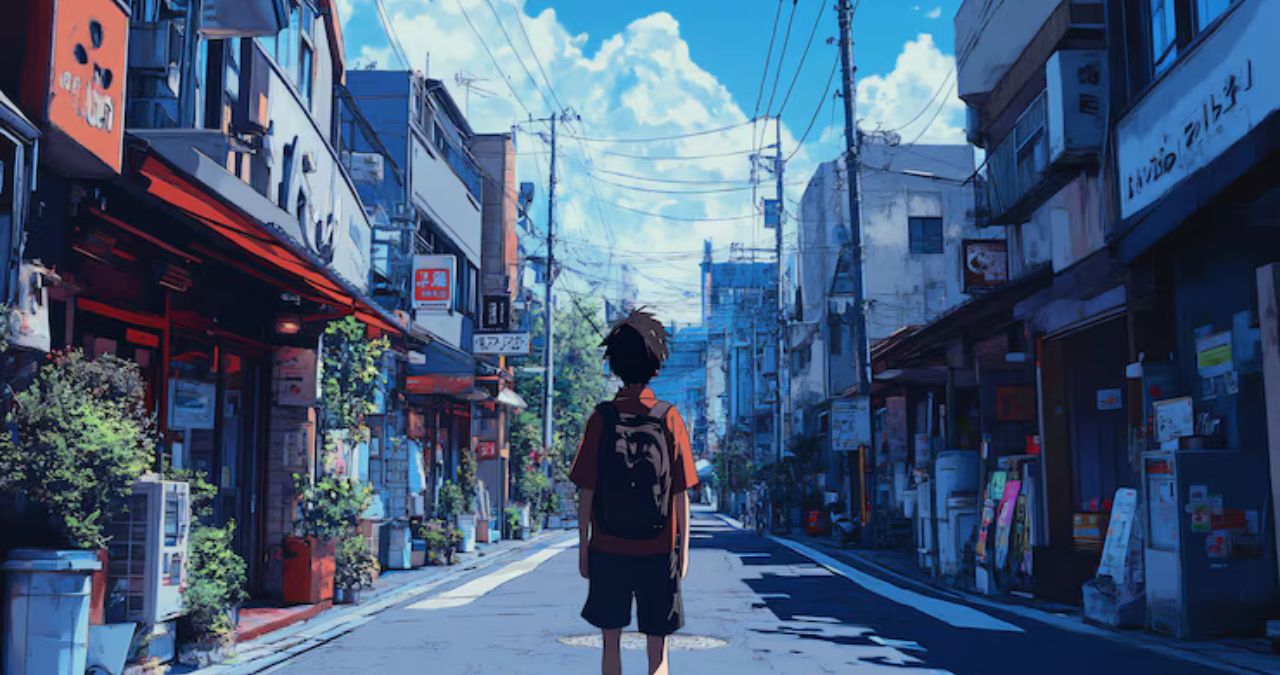BLOG
DoujinDesu: Your Gateway to Manga and Doujinshi Culture

Curious about exploring the vibrant world of manga and doujinshi? Whether you’re new to the scene or a veteran manga enthusiast, DoujinDesu is your one-stop hub for immersing yourself in this rich and creative subculture.
This blog will introduce you to DoujinDesu, outlining its role in spreading manga and doujinshi culture, explaining why so many fans swear by it, and offering tips on how to make the most of this popular platform. Let’s take a deep look into why DoujinDesu is earning its place as a pillar of the manga and doujinshi universe.
What is Doujinshi?
Before we jump into DoujinDesu, it’s essential to understand what doujinshi is. If you’re already a manga fan, you probably know a thing or two, but for newcomers, here’s a quick explanation.
Doujinshi refers to self-published works, often created by fans or indie artists. These works can include manga, short stories, illustrations, and even fan art. Many creators draw inspiration from existing anime or manga, creating their own spin-offs, alternate endings, or side stories. But you’ll also find completely original works that explore unique characters and plots.
Why is doujinshi so popular? Simply put, it provides a space for unfiltered creativity. Without the constraints of traditional publishing, creators have the freedom to experiment, catering to niche audiences or taking massive creative risks.
Why DoujinDesu?
DoujinDesu has positioned itself as a leading platform for discovering and enjoying manga and doujinshi. But what makes it stand out in a world brimming with manga platforms?
1. Extensive Library of Content
DoujinDesu offers a massive collection of manga and doujinshi that spans countless genres, styles, and themes. From heartwarming slice-of-life stories to thrilling adventures or even mature genres, DoujinDesu ensures there’s something for everyone.
This broad variety enables fans to discover new favorites, revisit classics, and even explore obscure works that are typically hard to find elsewhere.
2. Accessibility
Another big draw of DoujinDesu is its accessibility. Many manga fans find it difficult to acquire official or rare titles, especially outside Japan. DoujinDesu bridges this gap by offering easy access to a wealth of works, often available for download or online viewing.
3. A Platform for Creators
For aspiring and independent manga creators, DoujinDesu is a goldmine. The platform celebrates rising talent and creativity, giving creators an opportunity to showcase their work to a global audience. It’s a community-first space that supports and highlights the wide-ranging talent within the doujinshi world.
4. User-Friendly Experience
DoujinDesu emphasizes ease of use. Its intuitive interface makes it simple for users to search for specific titles, genres, or trends. Whether you want to casually browse or use advanced filters to zero in on a favorite series, it’s a seamless, frustration-free process.
5. Fan-Centered Features
DoujinDesu isn’t just a platform; it’s a hub for fans. Community features such as forums, ratings, and comments allow readers to connect, share their thoughts, and engage with like-minded enthusiasts.
Expanding the Appeal Beyond Doujinshi
Although DoujinDesu focuses on doujinshi, it also serves as a gateway to broader manga culture. Manga often mirrors societal trends, taps into readers’ emotions, and even influences global pop culture. DoujinDesu acts as a bridge, connecting fans worldwide and exposing them to the sheer diversity and creativity in the world of manga.
How to Get Started on DoujinDesu
Step 1: Explore by Genre or Tags
Start by browsing genres that interest you the most. Are you into romantic comedy, supernatural thrillers, or parody spin-offs of your favorite anime? DoujinDesu makes it easy to find what you’re looking for, with lists sorted by theme, popularity, or recency.
Step 2: Follow Creators
Once you’ve found a creator whose style or stories you love, don’t hesitate to dig deeper into their portfolio. Many creators use platforms like DoujinDesu as their primary stage, so you might uncover rare gems or even become part of their initial fandom.
Step 3: Join the Community
Interaction enhances the experience! Whether it’s leaving a review or jumping into comment threads, contributing your perspective is a great way to connect with others and further immerse yourself in the culture.
Step 4: Support Indie Talent
Most doujinshi creators are independent artists who rely on fan support. If you love a particular piece of work, consider purchasing items, subscribing to their Patreon, or simply sharing their content on your social channels.
Why Doujinshi Matters in Manga Culture
Doujinshi is more than just fan-made creations; it’s a creative lifeline of the manga industry. Established authors like CLAMP and Tite Kubo (of Bleach fame) started their careers creating doujinshi. It’s a space where aspiring creators hone their skills, refine their craft, and find their voice.
For readers, it’s a source of endless discovery. Doujinshi allows stories to continue long after the official volumes end, filling the gaps left behind by cliffhangers or adding depth to beloved characters.
Actionable Resources for Manga Fans
DoujinDesu is more than just a platform for reading and discovering. It’s also a tool for learning from and supporting creators. Here are a few resources you’ll want to explore further:
- Translation Communities: Many translation projects focus on bringing lesser-known doujinshi to a broader audience.
- Fan Projects and Collaborations: Join communities for fan translations, art collaborations, and cosplay events inspired by doujinshi.
- Create Your Own Doujinshi: Feeling inspired? Many doujinshi creators began as fans just like you. Leverage tools like Clip Studio Paint or MediBang to start your own creative projects.
Final Thoughts
DoujinDesu doesn’t just provide manga fans a place to enjoy curated content; it’s a celebration of creativity, community, and passion for stories in their many forms. Whether you want to lose yourself in romantic daydreams or explore the darker corners of manga-inspired worlds, DoujinDesu has you covered.
If you haven’t already, now’s the time to experience DoujinDesu. Start browsing, follow incredible indie creators, and immerse yourself in a world of storytelling that’s as diverse as it is inspiring.
BLOG
Sanaa Chappelle: An Exploration of Her Life and Influence

In the vast landscape of modern influencers, Sanaa Chappelle stands out, captivating audiences with her unique blend of style, creativity, and passion for social causes. From her early beginnings to her rise in the entertainment industry, Sanaa Chappelle is much more than just a name; she embodies a personality that resonates with her followers and drives change every day.
The Early Life of Sanaa Chappelle
Sanaa Chappelle was born and raised in a city that embraces diversity and creativity. Growing up in a nurturing family, Sanaa was encouraged to express herself artistically from a young age. This creative spirit manifested itself in various forms, including visual arts, performance, and even writing. Sanaa often credits her family for instilling in her the confidence to pursue her dreams, emphasizing the importance of support systems in fostering talent.
Education and Personal Growth
Sanaa Chappelle pursued her education with diligence and purpose, aiming not only for academic excellence but also for a holistic understanding of the world around her. While attending high school, she began to explore the realms of acting and fashion, participating in plays and community events that showcased her talents. This early exposure served as a catalyst for her future endeavors, igniting a passion that would define her career.
Her college years were marked by a commitment to personal growth and development. Sanaa chose a path that combined her love for the arts with a desire to make a difference in her community. Majoring in Arts and Social Sciences, she learned the importance of using her platform to bring about positive change. This unique combination of education and passion would later play a crucial role in shaping her identity as an influencer.
Sanaa Chappelle’s Rise to Fame
Sanaa Chappelle’s journey into the limelight began when she started sharing her talents on social media. Her engaging personality, combined with her keen sense of style, attracted a growing audience. Through platforms like Instagram and TikTok, Sanaa discovered her knack for connecting with people from all walks of life.
Social Media Impact
With each post, Sanaa Chappelle showcased her creativity, whether it was through fashion hauls, beauty tutorials, or lifestyle vlogs. Her authenticity shone through, making followers feel as though they were getting to know a friend rather than just an influencer. As her following grew, Sanaa leveraged her platform to raise awareness about various social issues, from mental health to environmental sustainability.
Sanaa’s commitment to authenticity has set her apart in an industry that often thrives on perfectionism. She is not afraid to share her struggles and triumphs, inviting her followers to join her on her journey. This vulnerability has resonated deeply with her audience and fostered a strong sense of community around her brand.
Collaborations and Achievements
As her influence expanded, Sanaa Chappelle caught the attention of various brands looking to collaborate with budding influencers. Through strategic partnerships, she has been able to promote ethical brands and advocate for causes she is passionate about. Sanaa’s collaborations range from fashion lines to eco-friendly products, showcasing her belief in making a positive impact through her work.
Her achievements have not gone unnoticed; Sanaa has received accolades and recognition within the industry, including nominations for influencer awards and features in popular lifestyle magazines. These accomplishments reflect not only her talent but also her determination to use her influence for good.
Sanaa Chappelle’s Advocacy Work
One of the most compelling aspects of Sanaa Chappelle’s journey is her dedication to advocacy. She firmly believes that influencers have a responsibility to use their platforms for positive change. This belief drives her to engage in various initiatives that aim to uplift marginalized communities and raise awareness about critical social issues.
Mental Health Awareness
Sanaa is particularly passionate about mental health advocacy. She often shares her own experiences, helping to destigmatize discussions surrounding mental health struggles. By opening up about her journey, Sanaa fosters a safe space for her followers, encouraging them to prioritize their mental well-being and seek help when needed.
Environmental Sustainability
In addition to mental health, Sanaa Chappelle is an ardent advocate for environmental sustainability. She highlights the importance of conscious consumerism and encourages her followers to make eco-friendly choices. Through campaigns and social media challenges, Sanaa inspires her audience to reduce waste and support sustainable practices.
The Future of Sanaa Chappelle
As Sanaa Chappelle continues to grow her influence, the future looks bright. With an ever-expanding audience, she has the potential to make an even greater impact in the realms of fashion, mental health, and social justice. Sanaa’s brand is built on authenticity, compassion, and creativity—qualities that will undoubtedly propel her forward.
Vision for the Future
Sanaa envisions a future where influencers consistently use their platforms to inspire positive change. She aims to take on more significant projects and campaigns that align with her values. Through collaborations with non-profits and community organizations, Sanaa hopes to create initiatives that empower others and foster a sense of belonging.
Conclusion
Sanaa Chappelle is more than a social media influencer; she is a force for good in the world. From her early experiences to her current accomplishments, her journey is a testament to the power of authenticity and compassion. As she continues to rise in prominence, we can only anticipate the incredible things she will achieve and the positive changes she will inspire.
BLOG
Chris Unclesho: An In-Depth Exploration

In the vast landscape of the digital age, certain personalities stand out for their unique contributions, innovative approaches, and the way they resonate with audiences. One such figure is Chris Unclesho. This article aims to delve into the life, achievements, and influence of Chris Unclesho, illustrating why he has garnered attention and respect online and beyond.
Who is Chris Unclesho?
Chris Unclesho is a multifaceted individual who wears many hats—be it as an entrepreneur, influencer, or creative professional. While information on him may be relatively niche, those who follow his work understand the depth and breadth of his contributions. He has cultivated a presence across various platforms, making him a noteworthy figure to explore.
The Rise of Chris Unclesho
Early Life and Background
While specific details about Chris Unclesho’s early life are sparse, it is common for successful individuals to have unique narratives that shape their journey. Often, personal experiences and challenges form the foundation upon which they build their careers. Chris may have encountered obstacles that fueled his ambitions and led him to pursue his passions fervently.
Education and Skill Development
Education plays a pivotal role in shaping personalities and equipping them with essential skills. Chris Unclesho likely benefited from academic pursuits or hands-on experience in his field. The blend of theoretical knowledge and practical application often sets the stage for innovation and creativity.
Chris Unclesho’s Professional Journey
Entrepreneurial Ventures
Entrepreneurship is a challenging yet rewarding path, and Chris Unclesho epitomizes this journey. His ventures are marked by innovation and a keen understanding of market dynamics. By identifying gaps in the market and leveraging his skills, Chris has carved a niche for himself. Highlighting some of his key business endeavors can provide insight into his strategies and mindsets.
Social Media Influence
In today’s world, social media presence can significantly propel an individual’s career. Chris Unclesho’s adeptness at navigating various social media platforms has allowed him to connect with a diverse audience. This ability not only enhances his visibility but also enables him to share his insights and build a community around his brand.
Content Creation and Digital Media
One of the standout aspects of Chris Unclesho’s career is his engagement with content creation—be it through blogs, videos, podcasts, or social media posts. Content creation is essential in establishing authority and building a loyal follower base. Through relatable and engaging content, Chris has been able to communicate his ideas effectively and resonate with his audience.
The Unique Contributions of Chris Unclesho
Creativity and Innovation
Chris Unclesho’s work embodies creativity and a forward-thinking approach. He often challenges conventional norms and introduces fresh perspectives. This innovative mindset not only sets him apart but also inspires others to think outside the box.
Empowering Others
Another remarkable aspect of Chris Unclesho’s journey is his commitment to empowering others. Whether through mentorship, collaborative projects, or sharing knowledge, he encourages individuals to pursue their own paths and realize their potential. By fostering a supportive environment, he contributes positively to his community.
The Impact of Chris Unclesho
Community Building
Community is essential in today’s interconnected world, and Chris Unclesho has been instrumental in creating strong networks of individuals who share common interests and goals. By forging connections, he not only enhances his reach but also nurtures relationships that can lead to collective growth.
Advocacy and Influence
In addition to his entrepreneurial and creative endeavors, Chris Unclesho likely leverages his platform for advocacy. Whether it’s championing social causes or raising awareness about important issues, influencers wield considerable power. Chris’s ability to use his voice for the greater good can amplify messages that deserve attention.
Conclusion: The Legacy of Chris Unclesho
In summary, Chris Unclesho is more than just a name; he represents a blend of creativity, entrepreneurship, and community engagement. His journey is a testament to the transformative power of dedication, resilience, and innovation. As we continue to explore the digital age, figures like Chris Unclesho remind us of the impact that one individual can have on countless lives.
By examining his contributions and philosophy, we gain valuable insights into the essence of success in our contemporary world—where adversity can breed innovation and collective growth can emerge from individual journeys. As Chris Unclesho continues to evolve and impact his surroundings, the story of his life remains a compelling narrative that encourages others to pursue their dreams with fervor and creativity.
BLOG
VF1H-1 50MHz: Understanding Its Applications and Benefits

In the world of radio frequency (RF) technology and electronic systems, certain components stand out due to their precision, versatility, and impact on modern communications infrastructure. The VF1H-1 50MHz oscillator is one such component that has garnered attention in various industries, from telecommunications to scientific instrumentation. Despite its technical specificity, understanding the VF1H-1 50MHz’s applications and benefits is crucial for engineers, hobbyists, and professionals seeking high-performance frequency control solutions.
This comprehensive article explores the VF1H-1 50MHz oscillator, its core functionalities, practical applications, and the advantages it offers in contemporary electronic systems.
What is VF1H-1 50MHz?
The VF1H-1 50MHz refers to a Voltage-Controlled Crystal Oscillator (VCXO) that operates at a center frequency of 50 megahertz (MHz). Oscillators like the VF1H-1 are essential electronic components that generate a precise frequency signal, which serves as a timing reference in circuits.
The “VF1H-1” is typically a model designation used by manufacturers to categorize a specific series of high-stability VCXOs designed for applications where precise frequency control and minimal phase noise are critical.
Key Specifications:
-
Center Frequency: 50MHz
-
Voltage-Controlled Tuning Range: Allows fine adjustment of frequency
-
Low Phase Noise: Essential for clean signal output
-
High Stability and Accuracy
-
Compact Form Factor: Suitable for integration into small devices
These attributes make the VF1H-1 50MHz a go-to choice for applications requiring reliable frequency sources with minor adjustability.
The Importance of Oscillators in Electronics
Oscillators are fundamental in electronics because they provide stable timing signals for various components and systems. From digital clocks in microprocessors to carrier waves in wireless communication, oscillators ensure that electronic operations are synchronized and accurate.
VCXOs like the VF1H-1 differ from fixed-frequency oscillators by offering voltage-controlled tuning. This means their output frequency can be finely adjusted by varying an input voltage, making them versatile in systems that demand dynamic frequency alignment.
Applications of VF1H-1 50MHz
1. Telecommunication Systems
In telecommunications, maintaining precise timing across networks is critical to ensure data integrity and efficient signal transmission. The VF1H-1 50MHz oscillator serves as a stable clock reference in:
-
Base stations
-
Satellite communication systems
-
Optical transmission equipment (like SONET/SDH networks)
VCXOs help correct minor frequency drifts caused by environmental factors, thereby keeping the communication systems in lockstep with network timing standards.
2. Radio Frequency (RF) and Microwave Systems
The 50MHz frequency range is commonly used as an intermediate frequency (IF) in RF systems. The VF1H-1 50MHz oscillator provides the stable reference needed in:
-
Frequency synthesizers
-
RF transceivers
-
Test equipment for RF signal generation
Because of its low phase noise characteristics, this oscillator ensures cleaner signals, which is essential in minimizing interference and improving signal clarity in RF chains.
3. Test and Measurement Instruments
Precision is paramount in scientific instruments. Oscillators like the VF1H-1 are integrated into:
-
Spectrum analyzers
-
Network analyzers
-
Frequency counters
These devices rely on high-stability oscillators to maintain accurate measurement standards during calibration and testing procedures.
4. Broadcast Equipment
In the broadcasting sector, VF1H-1 50MHz oscillators are used in:
-
TV transmitters and receivers
-
Radio broadcasting transmitters
-
Synchronization of audio and video signals
Ensuring that the transmitted signals remain coherent and synchronized is essential for delivering high-quality broadcasts without distortion or lag.
5. Military and Aerospace Systems
The VF1H-1 50MHz is suitable for military and aerospace applications due to its durability and precision. Potential uses include:
-
Radar systems
-
Navigation equipment
-
Secure communication systems
In these environments, oscillators need to withstand harsh conditions while delivering reliable frequency stability, a criterion the VF1H-1 series meets.
6. Industrial Automation and Control Systems
Industrial automation systems rely on precise timing to coordinate the operations of robotic arms, sensors, and control units. Oscillators like the VF1H-1 50MHz are used in:
-
Programmable Logic Controllers (PLCs)
-
Synchronization of factory automation lines
-
Industrial Internet of Things (IIoT) devices
Benefits of VF1H-1 50MHz Oscillators
A. Exceptional Frequency Stability
One of the most significant advantages of the VF1H-1 50MHz is its exceptional frequency stability, which ensures minimal deviation over time and across varying environmental conditions.
B. Voltage-Controlled Fine Tuning
The VCXO design allows for fine-tuning of the output frequency. This adjustability is critical for systems that require dynamic frequency alignment or need to compensate for minor drift without replacing components.
C. Low Phase Noise Performance
Low phase noise is crucial in applications like RF communications and precise measurements. The VF1H-1 offers a low phase noise output, ensuring signal clarity and reducing jitter, which can otherwise degrade system performance.
D. Compact and Versatile Integration
Designed in a compact form factor, the VF1H-1 50MHz oscillator can be easily integrated into space-constrained devices, making it ideal for modern compact electronics without compromising performance.
E. Reliability in Harsh Environments
For military, aerospace, and industrial applications, reliability is non-negotiable. The VF1H-1 series is manufactured to endure temperature extremes, mechanical shocks, and electromagnetic interference, making it a trusted component for mission-critical systems.
Choosing VF1H-1 50MHz: Factors to Consider
When selecting a VF1H-1 50MHz oscillator for your project, it’s essential to evaluate:
-
Voltage Control Range: Ensure the control voltage matches your circuit design.
-
Temperature Stability: Choose a model with a temperature coefficient that suits the operating environment.
-
Phase Noise Requirements: Align the phase noise specifications with the demands of your application.
-
Package Size and Pin Configuration: Verify physical dimensions for PCB design compatibility.
-
Supply Voltage and Power Consumption: Important for battery-powered and portable devices.
The Future of Oscillators and VF1H-1’s Role
As technology trends move toward 5G networks, IoT ecosystems, and autonomous systems, the demand for high-stability, tunable oscillators like the VF1H-1 50MHz will continue to grow. The integration of oscillators into System-on-Chip (SoC) solutions and miniaturized modules will necessitate compact yet powerful components.
Furthermore, as industries increasingly prioritize low-power and high-precision devices, components like the VF1H-1 50MHz, with their blend of stability, tunability, and reliability, are poised to remain integral to future designs.
Conclusion
The VF1H-1 50MHz is more than just a frequency control device; it’s a critical component that ensures precision, reliability, and efficiency across a multitude of industries. From telecommunications and broadcasting to scientific instrumentation and military applications, its versatility and robust performance make it a preferred choice for engineers and system designers.
-

 HOME3 months ago
HOME3 months agoMary Marquardt: The Untold Story of Her Life and Legacy
-

 FASHION3 months ago
FASHION3 months agoThe Enigma of “u231748506”: Decoding the Mystery Behind the Alphanumeric Sequence
-

 BLOG4 months ago
BLOG4 months agoYdesi: Exploring the Meaning, Significance, and Popularity
-

 HEALTH6 months ago
HEALTH6 months agoKerrigan Lawyer Yoga: A Unique Blend of Legal Expertise and Mindful Practice
-

 ENTERTAINMENT6 months ago
ENTERTAINMENT6 months agoUnderstanding WAVR-297: A Comprehensive Overview
-

 FASHION6 months ago
FASHION6 months agoErin Ann Shipka: A Rising Star with a Unique Legacy
-

 BLOG7 months ago
BLOG7 months agoInsanont: Exploring Its Meaning, History, and Impact
-

 BLOG5 months ago
BLOG5 months agoCorona1212 912023: A Comprehensive Guide to Understanding Its Impact and Significance
